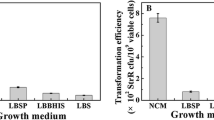Summary
Intact and osmotically sensitive cells of Corynebacterium glutamicum can be efficiently transformed by electroporation. This was shown by using the plasmid vector pUL-330 (5.2 kb), containing the kanamycin resistance gene of transposon Tn5. The following electric parameters yielded efficient transformation. For intact cells: one exponentially decaying field pulse \(E = E_0 exp( - t/\tau _E )\) with time constants \(\tau _E = 450 - 500\) and with initial field intensities of E 0=35–40 kV cm-1; prepulse temperature 20°C. Cell regeneration (survival) was 100%–80%. Transformation efficiency can be increased by an additional freeze and thaw cycle of the cells, prior to electroporation. Lysozyme treated cells (osmotically sensitive) were transformed with three successive pulses of E 0=25–30 kV cm-1. Cell regeneration under these conditions was found to be 20–30%. The optimum yield of transformants/μg plasmid-DNA was 3×103 for intact cells, 2×104 for intact cells which were frozen and thawed twice and 7×104 for osmotically sensitive cells if the cell suspension was pulsed at a cell density of 1–3×108/ml and at a DNA concentration of 0.2 μg/ml up to ≤2 μg/ml. The data obtained for osmotically sensitive cells suggest that the temperature increase accompanying the electric field pulse enhances colony formation and transformation efficiency if the initial prepulse temperature is ≥20°C, although regeneration of electroporated C. glutamicum cells starts to decrease at temperatures≥20°C.
Similar content being viewed by others
References
Birnboim HC, Doly J (1979) A rapid alkaline extraction procedure for screening recombinant plasmid DNA. Nucleic Acids Res 7:1513–1523
Chassy BM, Flickinger JL (1987) Transformation of Lactobacillus casei by electroporation. FEMS Microbiol Lett 44:172–177
Eigen M, DeMaeyer L (1963) Relaxation Methods. In: Friess SL, Lewis ES, Weissberger A (eds) Techniques of Organic Chemistry, Vol. 8, Pt. 2, John Wiley, New York, pp 895–1054
Fiedler S, Wirth R (1988) Transformation of Bacteria with Plasmid DNA by Electroporation. Analyt Biochem 170:38–44
Jacob HE, Förster W, Berg H (1981) Microbiological implications of electric field effects, II. Inactivation of yeast cells and repair of their cell envelope. Z Allg Mikrobiologie 21:225–233
Mac Neil DJ (1987) Introduction of plasmid DNA into Streptomyces lividans by electroporation. FEMS Microbiol Lett 42:239–244
Maniatis T, Fritsch EF, Sambrook J (1982) Molecular cloning: Laboratory manual. Cold Spring Harbour
Martin JF, Santamaria R, Sandoval H, Del Real G, Mateos LM, Gil JA, Aguilar A (1987) Cloning systems in amino acid-producing Corynebacteria. Biotechnol 5:137–146
Miller JF, Dower WJ, Tompkins LS (1988) High-voltage electroporation of bacteria: Genetic transformation of Campylobacter jejuni with plasmid DNA. Proc Natl Acad Sci USA 85:856–860
Neumann E, Rosenheck K (1972) Permeability changes induced by electric impulses in vesicular membranes. J Membrane Biol 10:279–290
Neumann E, Rosenheck K (1973) Potential difference across vesicular membranes. J Membrane Biol 14:194–196
Neumann E, Schaefer-Ridder M, Wang Y, Hofschneider PH (1982) Gene transfer into mouse lyoma cells by electroporation in high electric fields. EMBO J 1:841–845
Powell IB, Achen MG, Hillier AJ, Davidson BE (1988) A simple and rapid method for genetic transformation of lactic Streptococci by electroporation. Appl Environ Microbiol 54:655–660
Santamaria R, Gil JA, Martin JF (1985) High-frequency transformation of Brevibacterium lactofermentum protoplasts by plasmid DNA. J Bacteriol 162:463–467
Shillito RD, Saul MW, Paszkowski J, Müller M, Potrykus I (1985) High efficiency direct gene transfer to plants. Biotechnol 3:1099–1103
Shivarova N, Förster W, Jacob H-E, Grigorova R (1983) Microbiological implications of electric field effects VII. Stimulation of plamid transformation of Bacillus cereus protoplasts by electric field pulses. Z Allg Mikrobiol 23:595–599
Somkuti GA, Steinberg DH (1987) Genetic transformation of Streptococcus thermophilus by electroporation. In: Neijssel OM, Van der Meer RR, Luyben KCHAM (eds) Proc 4th Eur Congr Biotechnol, Vol 1, Elsevier, Amsterdam, p 412
Sugar IP, Förster W Neumann E (1987) Model of cell electrofusion, membrane electroporation, pore coalescence and percolation. Biophys Chem 26:321–335
Taketo A (1988) DNA transfection of Escherichia coli by electroporation. BBA 949:318–324
Teissie J, Rols MP (1986) Fusion of mammalian cells in culture is obtained by creating the contact between cells after their electropermeabilization. Biochem Biophys Res Commun 140:258–266
Thierbach G, Schwarzer A, Pühler A (1988) Transformation of spheroplasts and protoplasts of Corynebacterium glutamicum. Appl Microbiol Biotechnol 29:356–362
Yoshihama M, Higashiro K, Rao EA, Akedo M, Shanabruch WG, Follettie MT, Walker GC, Sinskey AJ (1985) Cloning vector system for Corynebacterium glutamicum. J Bacteriol 162:591–597
Author information
Authors and Affiliations
Rights and permissions
About this article
Cite this article
Wolf, H., Pühler, A. & Neumann, E. Electrotransformation of intact and osmotically sensitive cells of Corynebacterium glutamicum . Appl Microbiol Biotechnol 30, 283–289 (1989). https://doi.org/10.1007/BF00256219
Received:
Accepted:
Issue Date:
DOI: https://doi.org/10.1007/BF00256219




